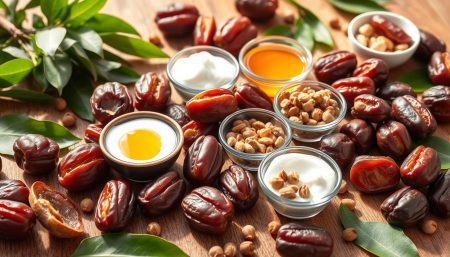Ever wondered if veggies are carbs? This guide will help you understand the carb content in different vegetables. We use data from the USDA and trusted health sources like Harvard Health Publishing. We’ll look at the carbs in veggies and how they affect our diet.
Vegetables do have carbs, but not all are the same. Some are high in starch, while others are low. This guide will help you understand carbs in veggies and how they fit into your diet. It’s perfect for those on low-carb or keto diets.
Join us as we explore if veggies are carbs. It’s a journey that will make you appreciate these plant-based foods even more.
Understanding Carbohydrates: A Brief Overview
Carbohydrates are key in diets around the world. They give us energy and help with many body functions. Knowing about carbs, like those in veggies, is vital for a balanced diet. This part will cover the basics and types of carbs, preparing us for more on their role in health.
What Are Carbohydrates and Their Role in Nutrition?
Carbohydrates are important nutrients that give us energy. They’re in foods like grains, fruits, and some veggies. Our bodies turn carbs into glucose, which powers our cells and organs.
The American Journal of Clinical Nutrition says carbs are good for heart health. They help control blood sugar and insulin levels. Knowing this helps us choose diets that keep us energized and healthy.
Different Types of Carbohydrates Found in Food
There are mainly three kinds of carbs: sugars, starches, and fibers. Each affects health in its own way:
- Sugars: Simple carbs that digest fast and can raise blood sugar quickly.
- Starches: In foods like potatoes and grains, they break down slower. This gives energy over time.
- Fibers: Important for digestion, found in many veggies. They slow down sugar absorption, helping control blood sugar.
Each carb type has its own role, affecting energy and how full we feel. Nutrition Reviews says a mix of these is key for a healthy diet and metabolism.
Eating a variety of carbs, like fiber in veggies, is good for health. As we learn more about carbs, their health effects, and where to find them, we see how important they are in planning our diets.
Are Vegetables a Carb?
People often wonder if vegetables are carbs. They are surprised to find that vegetables have carbs but also lots of good nutrients and fiber. Knowing the vegetable carb count and the different types is important. It helps when making diet choices, like on a keto diet.
The vegetable nutrition facts show that not all carbs are the same. Vegetables are full of fiber and nutrients, making them “good carbs.” This is different from “bad carbs” in processed foods, which have little nutrition and lots of sugar.
For those on a ketogenic diet, picking keto-friendly vegetables is key. These veggies have fewer carbs, helping to stay in ketosis.
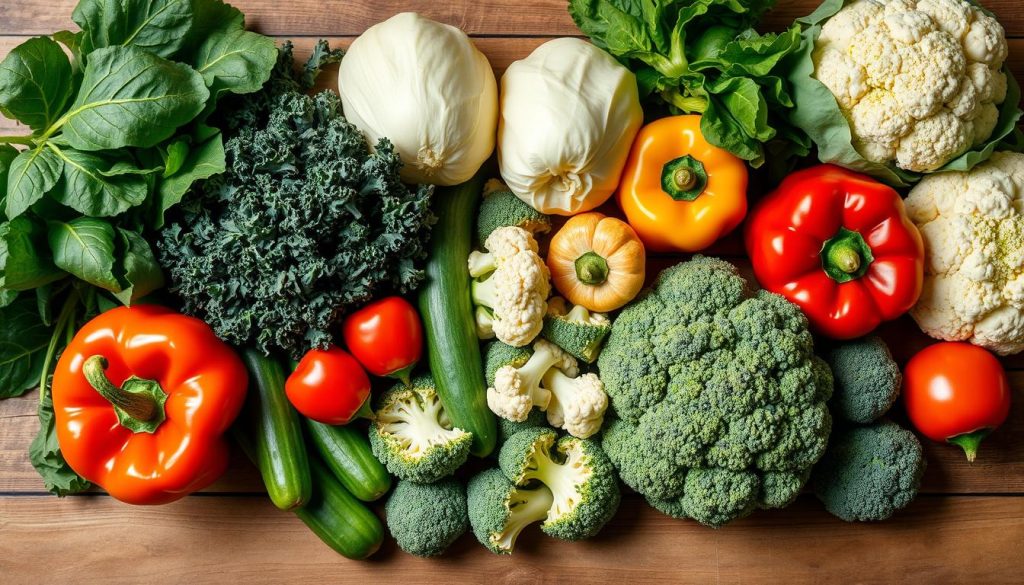
| Vegetable | Carbohydrate Content (per 100g) | Fiber Content (per 100g) | Net Carbs (per 100g) |
|---|---|---|---|
| Broccoli | 7g | 2.6g | 4.4g |
| Spinach | 3.6g | 2.2g | 1.4g |
| Cauliflower | 5g | 2g | 3g |
| Zucchini | 3.11g | 1g | 2.11g |
The table shows that vegetable carb count in keto-friendly options is lower. This is because you subtract the fiber. This makes them great for tracking carbs closely. It helps manage your diet and keeps the nutritional benefits of veggies without going over carb limits.
Breaking Down the Carbohydrate Content in Vegetables
Knowing the carb content in veggies is key for those with diabetes or on keto diets. Different veggies have different carb levels. This affects how they fit into your diet.
High Carb Vegetables versus Low Carb Options
Some veggies like corn, peas, and potatoes have more carbs. On the other hand, leafy greens, cucumbers, and bell peppers have fewer carbs. Choosing the right veggies can help control blood sugar and improve health.
Complex Carbs in Veggies: Fiber Counts
Dietary fiber is a type of complex carb found in many veggies. It helps with digestion, keeps you full, and controls blood sugar. Eating veggies high in fiber can help you eat a balanced diet.
Here’s a table showing the carb and fiber levels in some common veggies:
| Vegetable | Carb Content (per 100g) | Dietary Fiber (per 100g) |
|---|---|---|
| Broccoli | 6.64g | 2.6g |
| Carrots | 9.58g | 2.8g |
| Spinach | 3.63g | 2.2g |
| Kale | 8.75g | 3.6g |
| Cauliflower | 4.97g | 2.0g |
The Keto Perspective: Navigating Veggie Choices
For those on a ketogenic diet, picking the right veggies is key. You want to choose keto-friendly vegetables that are low in net carbs. This means the carbs minus fiber should be low. These veggies help keep blood sugar stable and support health, making them great for a keto diet.
What Makes a Vegetable Keto-Friendly?
A veggie is keto-friendly if it has low net carbs. It’s important to know the total carbs and fiber to get the net carbs right. Low carb vegetables are essential in a keto diet because you can eat more without going over carb limits.
List of Vegetables That Fit the Keto Diet
Here’s a list of veggies that are perfect for a ketogenic diet:
- Spinach – A versatile leafy green high in iron and magnesium.
- Broccoli – Rich in vitamin C and K, it’s great both raw and cooked.
- Cauliflower – Has a very low net carb content and can substitute for high-carb foods like rice.
- Zucchini – With a low carb count, it’s perfect for noodles or as a side dish.
- Avocado – Technically a fruit, but it’s low in carbs and high in healthy fats.
- Asparagus – Low in carbs and a great source of vitamins A, C, and K.
Adding these keto-friendly vegetables to your meals supports your keto diet. They also make sure you get important nutrients without breaking ketosis. Each veggie adds vitamins and minerals that boost your health.
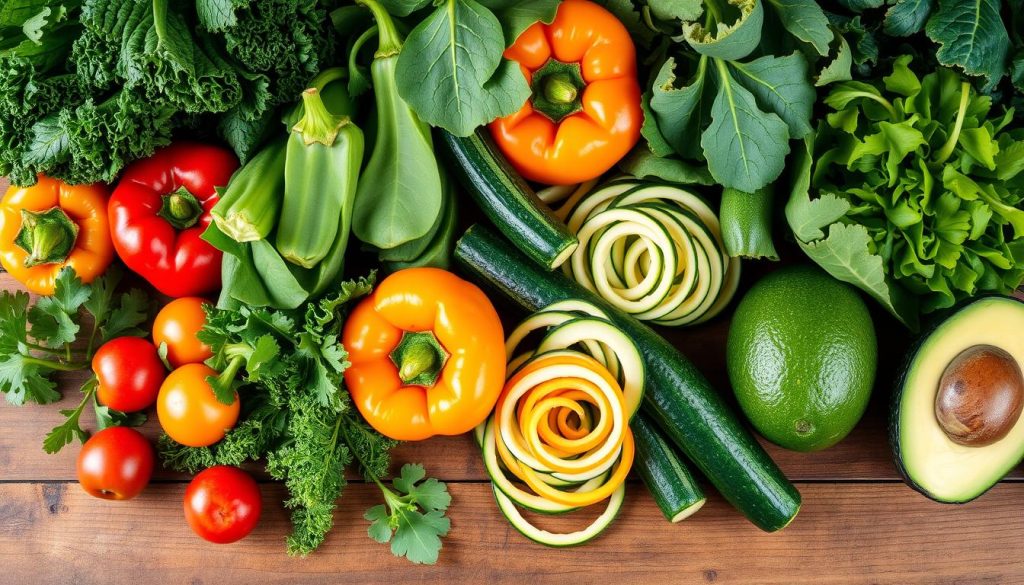
| Vegetable | Approximate Net Carbs (per 100g) |
|---|---|
| Spinach | 1.4g |
| Broccoli | 4.4g |
| Cauliflower | 3.2g |
| Zucchini | 2.2g |
| Avocado | 1.8g |
| Asparagus | 2.0g |
By picking veggies with lower net carbs, those on a keto diet can enjoy a variety of foods. This balance is key for health and diet success.
Vegetable Nutrition Facts: More Than Just Carbs
When we talk about vegetable nutrition facts, we must look at more than carbs. They are full of vitamins and minerals that keep us healthy. These nutrients are key to staying well, beyond just counting carbs. Exploring the nutritional density of veggies shows how they can help us eat well, even if we’re watching carbs.
Vitamins and Minerals in Your Favorite Veggies
Vegetables are packed with vitamins like A, C, K, and B vitamins. They also have minerals like iron, potassium, and magnesium. These help our bodies work right, from fighting off sickness to keeping our bones strong. Here’s a look at some top low carb veggies and their vitamin and mineral benefits:
- Spinach: Rich in Vitamin K, Vitamin A, and manganese
- Broccoli: High in Vitamin C and Vitamin K
- Asparagus: Good source of Vitamin K and folate
- Zucchini: Contains significant amounts of Vitamin B6
Understanding the Nutritional Density of Vegetables
The term nutritional density means how many nutrients a food has compared to its calories. Vegetables are very dense in nutrients but low in calories. This makes them perfect for diets that are both healthy and low in calories.
Here’s a comparison of some popular veggies to show their nutritional density:
| Vegetable | Calories per 100g | Main Nutrients |
|---|---|---|
| Kale | 49 | Vitamin A, Vitamin C, Vitamin K |
| Brussels Sprouts | 43 | Vitamin C, Vitamin K, Folate |
| Bell Peppers | 20 | Vitamin C, Vitamin B6, Vitamin A |
| Cauliflower | 25 | Vitamin C, Vitamin K, Folate |
Carb Content of Popular Vegetables: A Detailed Look
When looking at the carb content of popular vegetables, it’s key to know the difference between starchy and non-starchy ones. This knowledge helps people manage their diet better. It’s useful for those watching their carb intake for health or dietary reasons.
Starchy vs. Non-Starchy Vegetables: Carb Counts
Vegetables are divided into starchy and non-starchy types. Starchy ones, like potatoes and corn, have more carbs. They are good for people who need lots of energy. Non-starchy veggies, like kale and broccoli, have fewer carbs. They are better for those on low-carb diets.
| Vegetable | Type | Carb Content (per 100g) |
|---|---|---|
| Potatoes | Starchy | 17g |
| Corn | Starchy | 19g |
| Kale | Non-Starchy | 4g |
| Broccoli | Non-Starchy | 7g |
How Cooking Affects Carbohydrates in Vegetables
Cooking can change the carb content of vegetables. For instance, boiling starchy veggies can make them release glucose faster. Steaming or baking non-starchy veggies keeps their fiber, which is good for blood sugar control.
Knowing these differences is important for anyone watching their carb intake. It helps make better food choices.
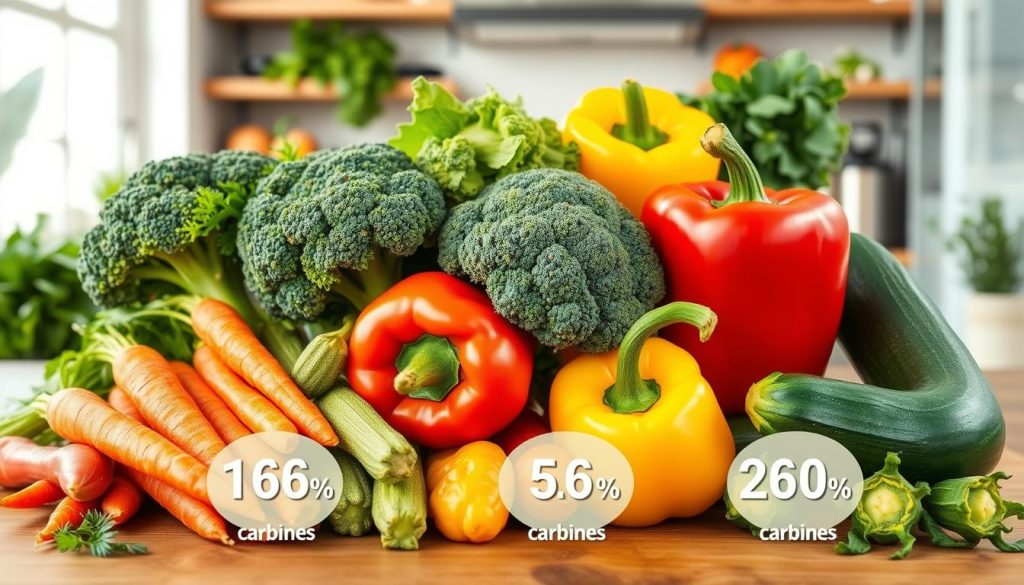
Best Low Carb Vegetables for Your Health Goals
Choosing the best low carb vegetables is key for those with diabetes or on a ketogenic diet. These veggies are low in carbs but rich in nutrients. They help control blood sugar and meet dietary needs.
These veggies are not only good for you but also easy to add to many meals. They’re great for daily diets focused on managing diabetes and staying in ketosis. Here’s a list of veggies that are low in carbs but packed with nutrients.
- Spinach
- Zucchini
- Broccoli
- Cauliflower
- Asparagus
- Mushrooms
- Kale
Each of these options fits well into a ketogenic diet and helps with managing diabetes. Here’s how some of these best low carb vegetables can boost your health:
| Vegetable | Carbs per 100g | Notable Health Benefits |
|---|---|---|
| Broccoli | 7g | Rich in vitamin C and K, aids in diabetes management and supports heart health |
| Cauliflower | 5g | High in fiber, improves digestion and balances blood sugar |
| Spinach | 3.6g | Excellent source of iron, magnesium, and essential vitamins |
Adding these veggies to your meals is a smart move for low carb diets. They’re versatile and can be used in many dishes. This keeps your diet interesting and fulfilling.
Creating a Balanced Diet with the Right Vegetable Carb Count
Having a balanced diet is key for good health and reaching your diet goals. It’s important to control your carb intake. A vegetable carb chart helps you pick the right veggies for your diet.
Incorporating Variety for Optimal Health
It’s important to eat a variety of veggies. They add flavor and give your body lots of nutrients. Each veggie has its own vitamins and minerals.
Using a vegetable carb chart, you can plan meals that are full of nutrients and fit your carb needs.
- Leafy greens like spinach and kale for iron and calcium
- Cruciferous vegetables such as broccoli and cauliflower for fiber and vitamin C
- Squashes and bell peppers for a sweeter flavor yet low in carbs
Measuring and Portion Control: Keeping Track of Carbs
Keeping track of your portions is vital for a balanced diet. It helps prevent eating too much, which is important for high-carb veggies. Use measuring cups or a digital food scale to control your portions.
Also, always check a vegetable carb chart to make sure your meals fit your carb goals.
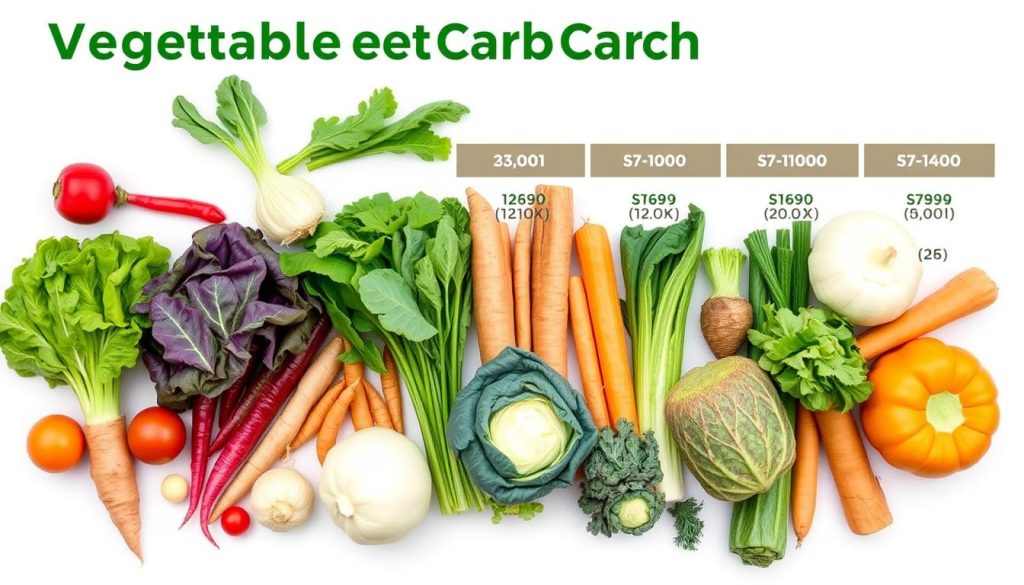
Following these tips helps keep your carb intake in check. It also makes sure your diet is colorful, varied, and full of nutrients. This is important for staying healthy and full of energy.
By using a vegetable carb chart and controlling your portions, you make smart choices every day.
Dietary Strategies Featuring Low Carb Vegetables
Adopting low carb dietary strategies means planning meals carefully. You need to include healthy, vegetable-based recipes. This method cuts down on carbs and boosts your health by using veggies’ natural benefits.
Meal Planning Tips for Lower Carbohydrate Intake
Planning meals low in carbs is key for those cutting down on carbs. Here are some tips to add low carb veggies to your diet:
- Begin your day with veggies by adding spinach or kale to smoothies.
- Swap high-carb sides like rice with cauliflower rice or mashed turnips.
- Make veggies the main focus of your meals, then add protein and healthy fats.
- Make vegetable soups and stews in bulk for quick, easy meals.
- Use lettuce wraps instead of bread for sandwiches and burgers.
These tips help lower carb intake and boost your vitamin and mineral intake.
Vegetables in a Low Carb Lifestyle: Recipes and Ideas
Adding veggies to your low carb diet can be tasty and fulfilling. Here are some creative, low-carb vegetable recipes:
- Zucchini noodles with pesto and cherry tomatoes.
- Roasted Brussels sprouts with crispy bacon and maple syrup.
- Stuffed bell peppers with ground turkey and low-carb veggies.
- Eggplant lasagna, using eggplant instead of pasta.
- Cauliflower pizza crust with tomato sauce and veggies.
These dishes make veggies the stars, ensuring meals are healthy and fit your low carb goals.
| Vegetable | Recipe Idea | Estimated Carbs per Serving |
|---|---|---|
| Zucchini | Noodles with Pesto | 4g |
| Brussels Sprouts | Roasted with Bacon | 8g |
| Bell Peppers | Turkey Stuffed Peppers | 6g |
| Eggplant | Layered Lasagna | 7g |
| Cauliflower | Pizza with Veggies | 5g |
By adding these veggie-based recipes to your diet, you can enjoy tasty meals that follow your low carb plan. These dishes support a healthy lifestyle and offer a chance to enjoy homemade meals that meet your health goals.
Vegetable Carbs List: A Handy Reference Guide
For anyone following nutritional guides, knowing about carbs is key. This list helps you pick low-carb veggies. It uses data from trusted places like the Nutrient Data Laboratory and the International Food Information Council.
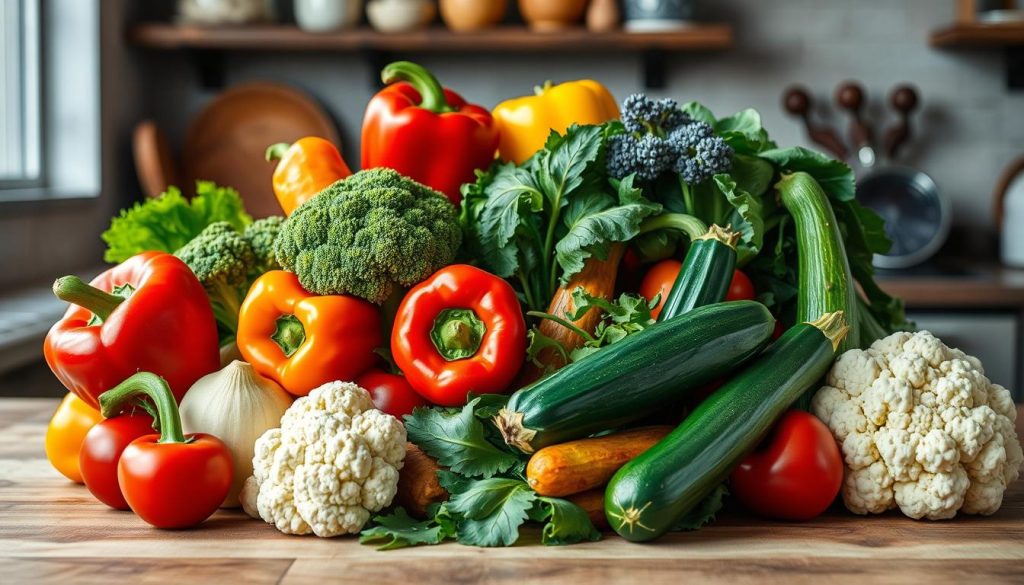
This list is more than just numbers. It’s a tool for everyday use. Whether you’re shopping, cooking, or meal planning, it makes healthy choices easier. Here’s a look at some common veggies and their carb counts per 100 grams:
| Vegetable | Carbohydrate Content (g) |
|---|---|
| Broccoli | 6.64 |
| Spinach | 3.63 |
| Carrots | 9.58 |
| Tomatoes | 3.89 |
| Bell Peppers | 4.64 |
| Cauliflower | 4.97 |
| Cucumber | 3.63 |
| Zucchini | 3.11 |
Use this list to pick veggies for your diet. It’s perfect for those on a low carb diet. This guide makes meal planning easier, helping you reach your health goals with tasty, healthy foods.
How to Read Vegetable Carb Chart and Labels
Learning to read nutritional information on vegetable packaging is easy. Just know how to use vegetable carb charts and interpreting food labels. This skill is key for anyone watching their carb intake.
Understanding a Vegetable Carb Chart: A vegetable carb chart helps pick veggies that fit your diet. It shows different veggies and how many carbs they have per serving.
- Look for Serving Size: Always check the serving size first to accurately compare the carbs in different vegetables.
- Total Carbohydrates: This includes all sugars, fiber, and starches found in the vegetable. It’s key for seeing if a veggie fits in your carb limit.
- Fiber Content: Subtract the grams of fiber from the total carbs if you’re counting net carbs. Net carbs are carbs that raise blood sugar levels.
Interpreting Food Labels: Food labels are full of nutritional information, like carbs. The FDA makes sure all packaged foods have labels with this info.
- Check the Ingredients: Ingredients are listed by how much is in them. For low-carb options, look for veggies at the top of the list.
- Understand % Daily Value: This shows how much of each nutrient in a serving of the food contributes to a daily diet. Use this to gauge the carb content relative to other essential nutrients.
| Vegetable | Serving Size | Total Carbs (g) | Fiber (g) | Net Carbs (g) |
|---|---|---|---|---|
| Broccoli | 1 cup | 6 | 2.4 | 3.6 |
| Spinach | 1 cup | 1.1 | 0.7 | 0.4 |
| Carrots | 1 cup | 12 | 3.6 | 8.4 |
Knowing how to use a vegetable carb chart and interpreting food labels is key. It helps make smart choices about the veggies you eat. Whether you’re on a diet or just trying to eat better, understanding these helps manage your nutrition well.
Exploring Root Vegetables: Are They High in Carbs?
Root vegetables like potatoes, carrots, and beets are common in many diets. They are known for their nutritional value and cooking versatility. But, those on a low carb diet wonder about their carb content. Let’s clear up myths and look at the root vegetables carb content to see how they fit into a low carb diet.
The Truth About Potatoes, Carrots, and Beets
The carb content in root vegetables varies a lot. For example, potatoes are often seen as high in carbs, which might scare off low carb dieters. On the other hand, carrots and beets have fewer carbs and are rich in fiber and nutrients. This makes them better for those watching their carb intake.
- Potatoes: A medium-sized potato contains about 37 grams of carbohydrates.
- Carrots: One medium carrot has about 6 grams of carbohydrates.
- Beets: A medium beet provides around 13 grams of carbohydrates.
While potatoes might seem like a challenge for a low carb diet, carrots and beets offer a more manageable option. They help keep your carb intake in check.
How to Enjoy Root Vegetables on a Low Carb Diet
It’s not hard to include root vegetables in a low carb diet. The trick is to control portion sizes and balance them with lower carb foods. Here are some tips:
- Choose smaller servings of high carb root vegetables like potatoes.
- Add carrots and beets to salads and soups for flavor without too many carbs.
- Try roasting or grilling root vegetables to bring out their sweetness. This can help reduce sugar cravings.
Knowing the root vegetables carb content and how it fits into your diet can let you enjoy these healthy foods. You don’t have to give up your health goals.
Impact of Cooking Methods on Vegetable Carb Content
Looking into how different cooking methods affect vegetable carbs and nutrients is key for a healthy diet. It’s known that cooking veggies can change their nutritional value.
Raw vs. Cooked: Which Retains Lower Carbs?
Raw veggies usually have less carbs than cooked ones. Cooking breaks down fiber and carbs into simpler forms, making them easier to digest. But, some cooking methods can help keep carbs lower.
Best Cooking Techniques for Preserving Nutrients
Some cooking methods are better than others for keeping nutrients and managing carbs. Steaming and blanching are great because they cook veggies just enough to make them safe and tasty. They also help keep vitamins and carbs from getting lost.
Sautéing is another good choice. It keeps nutrients and adds flavor without changing the carb content much. Just use a little oil and cook quickly to keep everything intact.
- Steaming – Cooks in a bit of water, keeping calories low and vitamins intact.
- Blanching – Quickly boils and then cools veggies fast, saving vitamin C and fiber.
- Sautéing – Cooks quickly over high heat, keeping nutrients and making veggies more flavorful.
Using these methods can help you eat a balanced diet and control carbs. They’re perfect for anyone watching their carb intake or aiming for certain nutritional goals.
Vegetable Snacks: Smart Carbohydrate Choices for On-The-Go
In today’s fast world, eating healthy on the move is tough. Vegetable snacks are great for your diet and help you stay low-carb. They are full of vitamins, minerals, and fiber, keeping you energized and full.
Healthy Veggie Snack Ideas for Low Carb Dieters
For those on a low carb diet, the right snacks are key. Vegetable snacks are tasty and filling. Here are some favorites:
- Raw carrot sticks and hummus
- Cucumber slices with herbed yogurt dip
- Cherry tomatoes filled with cottage cheese
- Bell pepper strips dipped in guacamole
For more snack ideas, check out this resource on fun and healthy options.
Prepping Veggies for Easy Access and Quick Nutrition
Getting your veggies ready is important for healthy snacks. Here’s how to prep them:
- Wash and cut veggies as soon as you buy them to save time.
- Put sliced veggies in clear containers in the fridge to stay fresh and easy to see.
- Package your snacks in bags for quick grabs.
Having prepped veggies makes meal planning easier and helps you avoid unhealthy snacks.
| Vegetable | Carb Content | Fiber Content (per 100g) |
|---|---|---|
| Broccoli | 6.64g | 2.6g |
| Carrots | 9.58g | 2.8g |
| Celery | 3.0g | 1.6g |
| Red Bell Pepper | 6.03g | 2.1g |
With these tips, adding vegetable snacks to your day is easy and fun. They’re perfect for anyone wanting to eat well without giving up taste or convenience.
Advantages of Growing Your Own Low Carb Vegetables
Starting a home garden is more than a hobby. It’s a move towards a self-sustaining diet. It brings many benefits, like adding more low carb foods to your meals. Growing your own low carb vegetables means you get them fresh. This is because they go from soil to your plate quickly.
Studies show that veggies picked at the right time taste better and are more nutritious. They don’t have to travel far or sit on shelves for weeks.
By growing your own veggies, you control how they grow. Organic gardening means less exposure to harmful chemicals. This makes your food healthier and safer to eat.
As the Agricultural Economics Journal points out, gardening can save money. A good garden can give you more food than you pay for in seeds and supplies. Plus, growing food locally helps the planet, as shown in the Sustainability in Agriculture journal.
Lastly, gardening brings joy and a sense of achievement. It’s easier to stick to low carb diets when you have fresh veggies at hand. It encourages people to start their own gardens, creating a new generation of gardeners.
While gardening has its challenges, the benefits of health, saving money, and personal satisfaction are worth it. Many Americans find it rewarding to adopt healthier, more sustainable eating habits through gardening.
FAQ
Q: Are vegetables a carb?
A: Yes, vegetables have carbs, but they vary. Knowing the carbs in veggies helps in making good food choices.
Q: What are the different types of carbohydrates found in food?
A: Food carbs are sugars, starches, and fibers. Each affects energy and health differently. Fiber is key for health and feeling full.
Q: Are all vegetables keto-friendly?
A: No, not all veggies fit a keto diet. Only low-carb veggies help keep you in ketosis.
Q: Which vegetables are considered low carb?
A: Low-carb veggies include leafy greens and cruciferous ones like broccoli. Also, cucumbers, zucchini, and bell peppers are good.
Q: How does fiber from vegetables influence health?
A: Fiber in veggies is great for digestion. It helps control blood sugar, keeps you full, and may lower disease risk.
Q: What makes a vegetable keto-friendly?
A: A keto veggie has low net carbs and doesn’t raise blood sugar. This supports ketosis.
Q: Can you provide a list of vegetables that fit the keto diet?
A: Keto-friendly veggies include spinach, kale, asparagus, avocados, mushrooms, and green beans. They have low net carbs.
Q: What vitamins and minerals can be found in vegetables?
A: Veggies are full of vitamins and minerals. You’ll find vitamin A, C, potassium, folate, and iron.
Q: How do starchy and non-starchy vegetables differ in carb counts?
A: Starchy veggies like potatoes have more carbs. Non-starchy ones like leafy greens have less.
Q: Does cooking affect the carbohydrates in vegetables?
A: Cooking can change how carbs in veggies are digested. Some methods might make carbs more concentrated.
Q: What are some of the best low carb vegetables for health goals?
A: Good low-carb veggies for health include spinach, broccoli, cauliflower, zucchini, and bell peppers. They’re nutrient-rich and don’t raise blood sugar much.
Q: How important is variety when incorporating vegetables into a low carb diet?
A: Variety is key for getting all nutrients and avoiding diet boredom. It’s important even on a low-carb diet.
Q: Why should one consider meal planning for a lower carbohydrate intake?
A: Meal planning helps stick to carb limits while keeping meals balanced and tasty. It’s essential for a low-carb diet.
Q: What would a handy vegetable carbs list provide?
A: A carbs list for veggies helps quickly choose low-carb options. It’s useful for those watching their carb intake.
Q: How can I properly read a vegetable carb chart and food labels for nutritional information?
A: Learn serving sizes and total carbs, fiber, and sugars. This helps manage carb intake effectively.
Q: Are root vegetables high in carbs, and can they be included in a low carb diet?
A: Root veggies are higher in carbs than leafy greens. But, they can fit in a low-carb diet in small amounts.
Q: What are the best cooking techniques to preserve nutrients in vegetables while keeping carbs low?
A: Steaming, blanching, and sautéing are best. They keep nutrients in veggies without adding carbs.
Q: Can you suggest healthy vegetable snack ideas for low carb dieters?
A: Healthy snack ideas include cucumbers, bell peppers, cauliflower, and celery. Pair them with hummus or a low-carb dip.
Q: What are the advantages of growing your own low carb vegetables?
A: Growing your own veggies offers fresh, organic produce. It can save money and give a sense of accomplishment.















